The Milvian Bridge played a crucial role in shaping the history of Europe and Christianity. Located on the Tiber River, north of Rome, the bridge was the site of the famous Battle of the Milvian Bridge, which took place on October 28, 312 AD. The battle saw Constantine the Great defeat his rival, Maxentius.
Constantine’s victory at the Milvian Bridge had lasting effects on both the religious landscape and the political structure. It paved the way for the Edict of Milan in 313 AD, which granted religious toleration throughout the empire. Furthermore, it contributed to the spread of Christianity as a dominant religion in the Roman Empire and established the foundation for the Christian Church to become a major societal force. In addition, the battle impacted the architectural and cultural heritage, with monuments like the Arch of Constantine standing as a testament to this significant historical event.
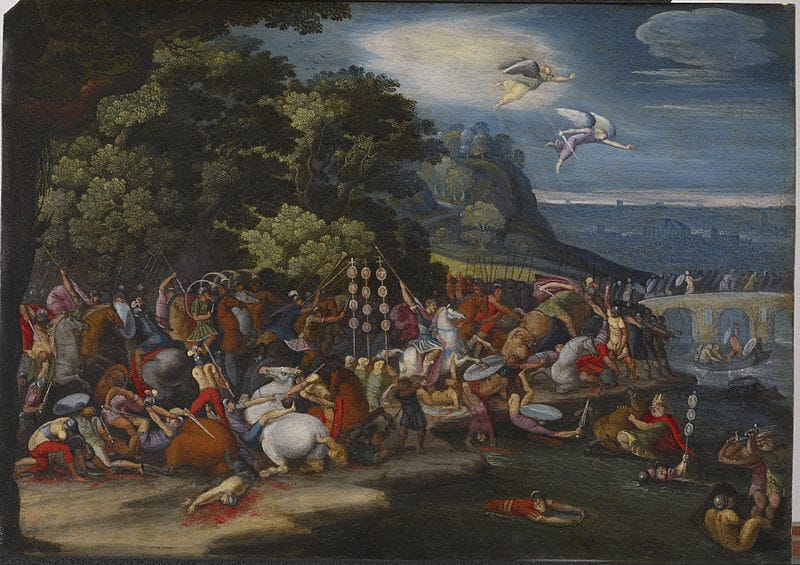
Key Takeaways
- The Battle of the Milvian Bridge was a decisive victory for Constantine and an important turning point for the Roman Empire.
- Constantine’s ascent marked the beginning of a shift in religious policy leading to the rise of Christianity within the empire.
- The conflict and its aftermath had a substantial influence on Roman architecture, culture, and the geopolitical landscape.
Historical Context
The Milvian Bridge, a pivotal locale in Roman history, was the setting of a momentous battle that shaped the history of the Roman Empire. This confrontation was a result of the deep-seated political and military turmoil characterizing the early fourth century, leading to the rise of Constantine and the fall of Maxentius.
Rise of Constantine
Constantine I, originally a ruler of Britain and Gaul, emerged as a key military power after Diocletian’s establishment of the Tetrarchy. In this power-sharing system, two senior emperors (Augusti) and two junior emperors (Caesars) governed the split Eastern and Western Roman Empires. Constantine’s ascent disrupted this balance, sparking a rivalry among claimants to the imperial throne.
Maxentius and the Tetrarchy
Maxentius, the son of the former emperor Maximian, seized power in Italy and Africa without being a recognized member of the Tetrarchy. Supported by the Praetorian Guard and the Roman Senate, his claim posed a direct threat to the established order. Maxentius’ rule was marked by internal battles and the quest for legitimacy, setting the stage for conflict with other emperors.
Roman Political Climate
The civil unrest in Rome reached its zenith when Constantine and Maxentius rivaled for dominance, leading to the civil war of the Tetrarchy. Amid this tumultuous political climate, allegiance shifted among soldiers and citizens alike, with repercussions felt across Milan, Gaul, Africa, Italy, and the Eastern provinces. The battle at the Milvian Bridge over the Tiber River would not only determine the fate of the Roman Empire but also signal a shift to a new epoch of emperors and empires.
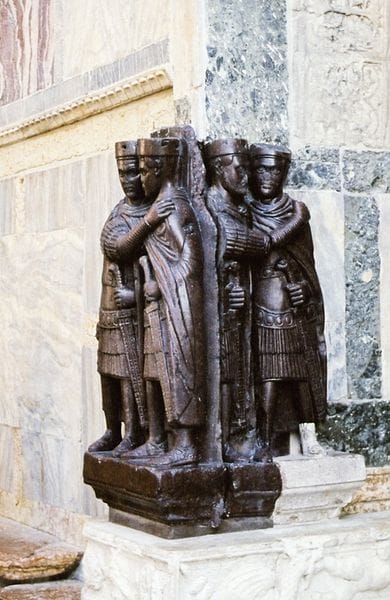
Milvian Bridge: The Battlefield
The Milvian Bridge, known in antiquity as Pons Milvius and today as Ponte Molle, was the stage for a pivotal encounter in Rome’s history. Its strategic location over the Tiber River shaped the course of Roman and European history.
Geographical Significance
Situated on the Tiber River, just north of Rome, the Milvian Bridge linked the city with the Via Flaminia, the crucial road that stretched across Italy to the Adriatic Sea. Its position made it a vital crossing point for the River Tiber, serving not only as a commercial artery but also as a strategic military route when controlling access to Rome.
Strategic Importance
During the Battle of the Milvian Bridge in 312 AD, the control of this bridge was critical in the struggle between Constantine I and Maxentius. As Constantine’s forces approached from the north following his invasion of Italy, the bridge formed a chokepoint that could have been used defensively by Maxentius. However, Constantine’s tactical maneuvering led to the construction of a temporary pontoon bridge parallel to the Pons Milvius, which played a decisive role in outflanking Maxentius’s troops and ensuring a victory that would ultimately lead to Constantine’s consolidation of power as the sole ruler of the Roman Empire.
The Battle
Conflict Preceding the Battle
The pivotal encounter between Constantine I and Maxentius, known as the Battle of the Milvian Bridge, occurred on October 28, 312. Tensions leading up to the Battle of the Milvian Bridge were rooted in the quest for absolute power within the Roman Empire. Constantine I, the Western Emperor, faced Maxentius, his rival, in a decisive battle for control. Constantine’s forces marched from Gaul, aiming to confront Maxentius, who had declared himself Emperor of Rome in a move that was not universally recognized. The conflict was essentially part of a wider Civil War, where each commander sought to eliminate the other as contenders to the imperial throne.
Details of the Clash
The battle itself was a formidable display of military strategy and might. Constantine’s army, comprised predominantly of infantry and supported by cavalry, was outnumbered by the forces of Maxentius. Despite this, Constantine’s troops were perhaps inspired by their leader’s vision, in which, as reported, he saw a cross in the sun and heard the message “In this sign, conquer.”
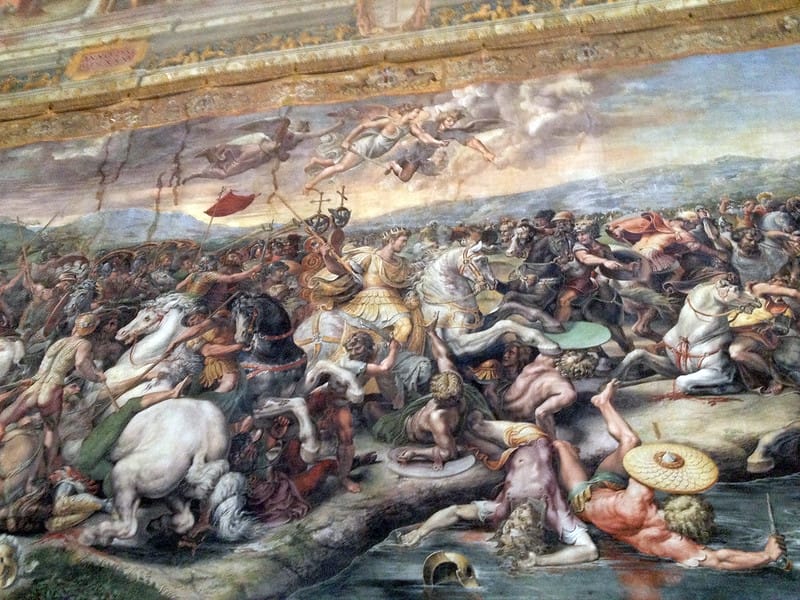
Source: https://flic.kr/p/pynqey
This vision may have led to the adoption of a symbol akin to the Christian cross on the soldiers’ shields. The armies clashed near the Milvian Bridge over the Tiber River, resulting in a chaotic struggle that saw the destruction of balustrades and significant casualties on Maxentius’ side, who were eventually pushed back towards the waterway. Maxentius himself perished, drowning in the river during the retreat.
Religious Significance
Constantine’s Conversion
The Milvian Bridge is a symbol of monumental change within the Roman Empire, marking the intersection of military triumph and religious fervor that catapulted Christianity from a persecuted faith to a position of power. At the heart of the Milvian Bridge’s religious significance is the event of Constantine’s conversion to Christianity. He saw a cross in the sky accompanied by the words “In Hoc Signo Vinces” — “In this sign, you will conquer.” This divine message prompted Constantine to adorn his soldiers’ shields with the Chi-Rho, the first two letters of Christ’s name in Greek, a symbol of Christian faith.
Christianity’s Ascendance
Constantine’s victory at the Milvian Bridge became a turning point for Christianity‘s rise from a marginalized religion to a dominant cultural and political force. As the first Roman Emperor to convert to Christianity, Constantine’s reign heralded a new era where Christianity began its path to becoming the official religion of the Roman Empire. The adoption of Christian symbols and practices by the state underscored a newfound respect and legitimacy for the once-persecuted believers. This event encapsulated the profound shift, solidifying a once obscure faith’s place at the center of Western civilization.
Sociopolitical Aftereffects
Edict of Milan
In 313 AD, following Constantine’s decisive victory, the Edict of Milan was proclaimed. This crucial declaration established religious tolerance throughout the empire, particularly legitimizing Christianity, which placed Constantine I and his ally Licinius at the forefront of monumental social reform. The edict granted Christians the freedom to practice their religion without persecution, a marked departure from previous policies.
Heirs and Legacies
Constantine’s reign not only heralded changes in religious policy but also set the stage for hereditary succession within the Roman Empire. Constantius, his father, and Helen, his mother, greatly influenced his rule. The concepts of hereditary power and the involvement of Praetorians and officials like Ruricius Pompeianus supported the development of a new era of leadership. Constantine’s victory and subsequent policies paved the way for his heirs to inherit power, contrasting sharply with the past instability marked by frequent usurper challenges.
Cultural and Monumental Legacy
The Milvian Bridge, known in Italian as Ponte Milvio, is not just an ancient structure but a significant cultural and historical landmark. Its legacy encompasses a wealth of architectural, religious, and artistic influences that span from antiquity to the present day.
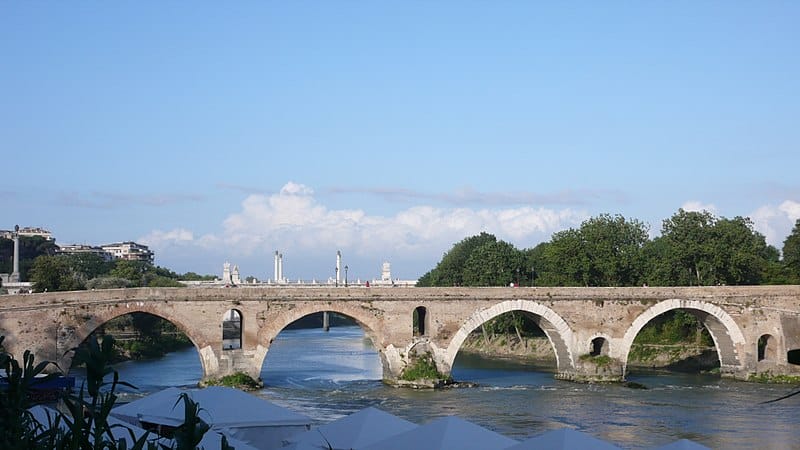
Source: Kyle Van Horn, CC BY 2.0 https://creativecommons.org/licenses/by/2.0, via Wikimedia Commons
Architectural Influences
Ponte Milvio is an embodiment of Roman engineering prowess. Originally constructed by Marcus Aemilius Scaurus in 109 BC, it was an important military and commercial artery, and its design has influenced bridge construction throughout the centuries.
The Triumphal Arch of the nearby Arch of Constantine shares a historical symbiosis with the bridge as an enduring symbol of victory and Roman might. Both structures reflect the grandeur of Roman architecture and its lasting impact on Western civilization.
In the 19th century, Giuseppe Valadier undertook a restoration of Ponte Milvio, bringing a neoclassical elegance to the structure while preserving its ancient heritage. This melding of old and new architectural elements underscores the bridge’s ongoing cultural relevance and adaptability over time.
Literary and Artistic Reflections
The Milvian Bridge is deeply rooted in Christian lore as the site of the battle, where Constantine I reportedly saw a vision of a Latin Cross and was instructed to mark his soldiers’ shields with a Halo, as per Lactantius‘ “De Mortibus Persecutorum.”
This pivotal event, leading to Constantine’s victory and a subsequent shift in religious tides toward Christianity, has been immortalized in countless literary and artistic representations. Eusebius, in his “Life of Constantine,” further enshrined the bridge’s divine association, intertwining its physicality with the spiritual ascent of Christianity.
The site’s connection to mystical prophecy is also linked to the Sibylline Books, emphasizing its role not only in real historical events but also in the mythological fabric of Roman culture. Throughout the Middle Ages and beyond, the bridge’s cultural and monumental legacy has continued to inspire a wealth of reflection in arts and literature, further cementing its place as an icon of civilizational crossroads.
Constantine’s Broader Influence
Emperor Constantine I’s reign marked a pivotal era in Roman and world history. His leadership extended far beyond his famous victory at the Milvian Bridge. Here are key aspects of his wider influence:
Unification and Administration: Constantine contributed significantly to unifying the Roman Empire. He centralized power and stabilized the realm after a period of crisis, managing provinces from Britain to Spain and the Gauls effectively.
Cultural Shifts: While not solely responsible for the transition from paganism to Christianity, his purported vision and victory associated with the Christian symbol at the Milvian Bridge played a critical role.
Legal Precedence: He instituted legal reforms that would underpin the later Byzantine legal codes. These changes echoed throughout Europe for centuries.
Military Reforms: His military strategies and organization bolstered Rome’s defenses and offensive capabilities, influencing the empire’s longevity.
| Area | Influence |
|---|---|
| Religion | Supported Christianity; convened the First Council of Nicaea |
| Legislation | Codified laws; inspired Byzantine codices |
| Military | Reorganized the army; fortified borders |
| Administration | Unified the Empire after the Tetrarchy; constructed Constantinople |
Constantine’s dream or vision before the battle has been subject to varied interpretations, both historical and superstitious, and remains a debated topic among scholars.
- Innovation and Construction: The founding of Constantinople – a new, strategically placed capital – demonstrates his foresight and enduring influence on urban development and architecture.
Constantine’s relationship with figures like Galerius and Maximian showcased his political acumen and determination to emerge as the sole emperor, which he achieved, thus shaping the governance model for future Roman emperors.
Conclusion
The victory of Constantine the Great over Maxentius not only solidified Constantine’s power but also set the stage for the rise of Christianity within the Roman Empire. It’s widely accepted that Constantine’s rule as the first Christian emperor was established following his triumph at the bridge.
Historians often scrutinize this crucial battle, debating the accuracy of various sources, such as Eusebius’s account, which suggests that Divine intervention played a role in Constantine’s victory. This interpretation has been contested, with some suggesting propaganda may have influenced the historical record. The truth and hagiography at the Milvian Bridge remain subjects of scholarly debate.
The date of the battle has also been a point of contention amongst scholars. Some historical compilations suggest different consulates and years, leading to a reevaluation of the timeline. This critical assessment of the battle’s date can be analyzed further in the literature on the subject, namely “The Battle of the Milvian Bridge: The Date Reconsidered.”
In assessing Constantine’s conversion and the implications of the Milvian Bridge, it is important to consider the broad array of interpretations and the complex historical context in which this battle unfolded. The conflict remains a significant area of research that continues to influence modern understandings of the intersection between politics, religion, and history.
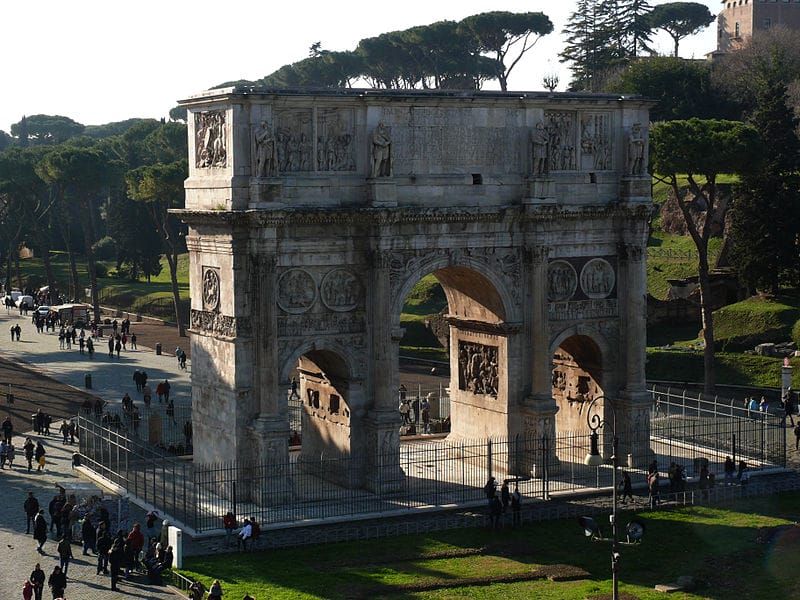
Source: David Jones, CC BY 2.0 https://creativecommons.org/licenses/by/2.0, via Wikimedia Commons
People Also Ask:
What were the major outcomes of the Battle of Milvian Bridge?
The Battle of Milvian Bridge culminated in the decisive victory of Constantine I, leading to his sole rule over the Roman Empire and the eventual acceptance of Christianity as a religion of the empire.
How has the Milvian Bridge changed since AD 312?
Since AD 312, the Milvian Bridge has undergone numerous reconstructions and renovations. It has also been the site of several battles, which have shaped its architectural and historical evolution.
What was the strategic significance of the Milvian Bridge in ancient warfare?
During ancient times, the Milvian Bridge served as a crucial passage across the Tiber River, making it a key strategic point for controlling access to Rome and for military movements.
Who were the key figures involved in the Battle of Milvian Bridge?
The primary figures in the Battle of Milvian Bridge were Constantine I, who became the first Christian emperor of Rome, and Maxentius, who was defeated and perished in the battle.
How does the Milvian Bridge feature in historical art and literature?
The Milvian Bridge is often depicted in art and literature as a symbol of Constantine’s divine vision and victory, serving as a narrative turning point in Roman and Christian histories.
Does the Milvian Bridge still exist?
Maxentius chose to make his stand in front of the Milvian Bridge, a stone bridge that carries the Via Flaminia road across the Tiber River into Rome (the bridge stands today at the same site, somewhat remodeled, named in Italian Ponte Milvio or sometimes Ponte Molle, “soft bridge”).
What role did the Praetorian Guard play in the events at the Milvian Bridge?
The Praetorian Guard, who were elite soldiers serving as the personal bodyguard of Roman emperors, played a significant role by siding with Maxentius during the battle. However, they were ultimately unable to secure a victory against Constantine’s forces.
Hello, my name is Vladimir, and I am a part of the Roman-empire writing team.
I am a historian, and history is an integral part of my life.
To be honest, while I was in school, I didn’t like history so how did I end up studying it? Well, for that, I have to thank history-based strategy PC games. Thank you so much, Europa Universalis IV, and thank you, Medieval Total War.
Since games made me fall in love with history, I completed bachelor studies at Filozofski Fakultet Niš, a part of the University of Niš. My bachelor’s thesis was about Julis Caesar. Soon, I completed my master’s studies at the same university.
For years now, I have been working as a teacher in a local elementary school, but my passion for writing isn’t fulfilled, so I decided to pursue that ambition online. There were a few gigs, but most of them were not history-related.
Then I stumbled upon roman-empire.com, and now I am a part of something bigger. No, I am not a part of the ancient Roman Empire but of a creative writing team where I have the freedom to write about whatever I want. Yes, even about Star Wars. Stay tuned for that.
Anyway, I am better at writing about Rome than writing about me. But if you would like to contact me for any reason, you can do it at contact@roman-empire.net. Except for negative reviews, of course. 😀
Kind regards,
Vladimir
